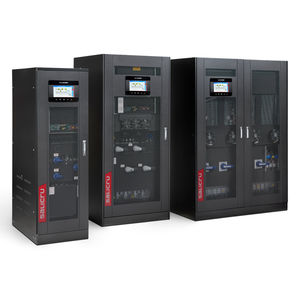
- Company
- Products
- Catalogs
- News & Trends
- Exhibitions
On-line UPS SLC TWIN RT3 4-10 kVAsingle-phaseAGMlead-calcium




Add to favorites
Compare this product
Characteristics
- Type
- on-line
- Electrical characteristics
- single-phase
- Battery type
- AGM, lead-calcium
- Applications
- server
- Other characteristics
- with LCD display, Eco mode, with built-in battery, rack-mount, tower
- Output power kVA
4 kVA, 5 kVA, 6 kVA, 8 kVA, 10 kVA
(5.4385 hp, 6.7981 hp, 8.1577 hp, 10.877 hp, 13.5962 hp)- Input voltage
Max.: 276 V
220 V, 230 V, 240 V
Min.: 110 V
- Output voltage
220 V, 230 V, 240 V
- Power
4,000 W, 5,000 W, 6,000 W, 8,000 W, 10,000 W
Description
On-line double conversion tower/rack IoT UPS from 4 kVA to 10 kVA with PF=1
Efficiency and reliability for the protection of critical data
Salicru’s SLC TWIN RT3 series of uninterruptible power supplies (UPS) ranges from 4 to 10 kVA and offers excellent electrical protection performance for critical server environments. Although the devices are designed to be incorporated into rack cabinets, they include all of the accessories and can be adapted for use in tower format. The models with a rating of 4 kVA and over include a power strip that can be rack-mounted or attached to the body of the UPS if the vertical format is chosen. This strip (also known as a power distribution unit or PDU) maximises the device’s electrical connectivity and enables the rapid connection/disconnection of the loads that are to be protected.
Users interact directly with the device via a dot matrix display that highlights important information by placing it in the centre of the screen, unlike traditional LCD screens.
Reliability, power density and immediacy of information are three of the key features that define the SLC TWIN RT3 series, as they make the biggest contribution to satisfying the demands of today’s users.
Catalogs
SLC TWIN RT3 4-10 kVA
4 Pages
SALICRU General Catalogue
204 Pages
Related Searches
- Power supply
- AC/DC power supply
- SALICRU on-line UPS
- Compact power supply
- 12 V battery
- Lead battery
- Programmable power supply
- Single-phase power supply
- Rectangular battery
- AC uninterruptible power supply
- SALICRU industrial UPS
- SALICRU three-phase UPS
- SALICRU single-phase UPS
- SALICRU UPS with LCD display
- Rack-mount power supply
- Inverter for solar applications
- Off-grid inverter
- Three-phase power supply
- Data center uninterruptible power supply
- Eco mode uninterruptible power supply
*Prices are pre-tax. They exclude delivery charges and customs duties and do not include additional charges for installation or activation options. Prices are indicative only and may vary by country, with changes to the cost of raw materials and exchange rates.




















